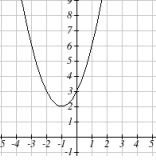Quadratic Equations With Complex Solutions
Learning Outcomes
- Use the quadratic formula to solve quadratic equations with complex solutions
- Connect complex solutions with the graph of a quadratic equation that does not cross the [latex]x[/latex]-axis
[latex]2x^2+3x+6=0[/latex]
Using the Quadratic Formula to solve this equation, we first identify a, b, and c.
[latex]a = 2,b = 3,c = 6[/latex]
We can place a, b and c into the quadratic formula and simplify to get the following result:
[latex]x=-\frac{3}{4}+\frac{\sqrt{-39}}{4}, x=-\frac{3}{4}-\frac{\sqrt{-39}}{4}[/latex]
Up to this point, we would have said that [latex]\sqrt{-39}[/latex] is not defined for real numbers and determine that this equation has no solutions. But, now that we have defined the square root of a negative number, we can also define a solution to this equation as follows.
[latex]x=-\frac{3}{4}+i\frac{\sqrt{39}}{4}, x=-\frac{3}{4}-i\frac{\sqrt{39}}{4}[/latex]
In this section we will practice simplifying and writing solutions to quadratic equations that are complex. We will then present a technique for classifying whether the solution(s) to a quadratic equation will be complex, and how many solutions there will be.
In our first example, we will work through the process of solving a quadratic equation with complex solutions. Take note that we will be simplifying complex numbers, so if you need a review of how to rewrite the square root of a negative number as an imaginary number, now is a good time.
Example
Use the Quadratic Formula to solve the equation [latex]x^{2}+2x=-5[/latex].Answer: First write the equation in standard form. [latex-display]\begin{array}{l}x^{2}+2x=-5\\x^{2}+2x+5=0\,\,\,\,\,\\\\a=1,b=2,c=5\,\,\,\end{array}[/latex-display] [latex-display] \begin{array}{r}{{x}^{2}}\,\,\,+\,\,\,2x\,\,\,+\,\,\,5\,\,\,=\,\,\,0\\\downarrow\,\,\,\,\,\,\,\,\,\,\,\,\,\,\downarrow\,\,\,\,\,\,\,\,\,\,\,\,\,\,\,\,\downarrow\,\,\,\,\,\,\,\,\,\,\,\,\,\,\,\,\,\,\\a{{x}^{2}}\,\,\,+\,\,\,bx\,\,\,+\,\,\,c\,\,\,=\,\,\,0\end{array}[/latex-display] Substitute the values into the Quadratic Formula. [latex-display] x=\frac{-b\pm \sqrt{{{b}^{2}}-4ac}}{2a}\\x=\frac{-2\pm \sqrt{{{(2)}^{2}}-4(1)(5)}}{2(1)}[/latex-display] Simplify, being careful to get the signs correct. [latex-display] x=\frac{-2\pm \sqrt{4-20}}{2}[/latex-display] Simplify some more. [latex-display] x=\frac{-2\pm \sqrt{-16}}{2}[/latex-display] Simplify the radical, but notice that the number under the radical symbol is negative! The square root of [latex]−16[/latex] is imaginary. [latex] \sqrt{-16}=4i[/latex]. [latex-display] x=\frac{-2\pm 4i}{2}[/latex-display] Separate and simplify to find the solutions to the quadratic equation. [latex-display]\begin{array}{c}x=\frac{-2+4i}{2}=\frac{-2}{2}+\frac{4i}{2}=-1+2i\\\\\text{or}\\\\x=\frac{-2-4i}{2}=\frac{-2}{2}-\frac{2i}{4}\cdot \frac{2}{2}=-1-2i\end{array}[/latex-display] Therefore, [latex]x=-1+2i[/latex] or [latex]-1-2i[/latex].
| [latex]\begin{array}{r}x=-1+2i\\x^{2}+2x=-5\\\left(-1+2i\right)^{2}+2\left(-1+2i\right)=-5\\1-4i+4i^{2}-2+4i=-5\\1-4i+4\left(-1\right)-2+4i=-5\\1-4-2=-5\\-5=-5\end{array}[/latex] | [latex]\begin{array}{r}x=-1-2i\\x^{2}+2x=-5\\\left(-1-2i\right)^{2}+2\left(-1-2i\right)=-5\\1+4i+4i^{2}-2-4i=-5\\1+4i+4\left(-1\right)-2-4i=-5\\1-4-2=-5\\-5=-5\end{array}[/latex] |
Example
Use the quadratic formula to solve [latex]{x}^{2}+x+2=0[/latex].
Answer: First, we identify the coefficients: [latex]a=1,b=1[/latex], and [latex]c=2[/latex]. Substitute these values into the quadratic formula. [latex]\begin{array}{l}x\hfill&=\frac{-b\pm \sqrt{{b}^{2}-4ac}}{2a}\hfill \\\hfill&=\frac{-\left(1\right)\pm \sqrt{{\left(1\right)}^{2}-\left(4\right)\cdot \left(1\right)\cdot \left(2\right)}}{2\cdot 1}\hfill \\\hfill&=\frac{-1\pm \sqrt{1 - 8}}{2}\hfill \\ \hfill&=\frac{-1\pm \sqrt{-7}}{2}\hfill \\\hfill&=\frac{-1\pm i\sqrt{7}}{2}\hfill \end{array}[/latex] Now we can separate the expression [latex]\frac{-1\pm i\sqrt{7}}{2}[/latex] into two solutions: [latex-display]-\frac{1}{2}+\frac{ i\sqrt{7}}{2}[/latex-display] [latex-display]-\frac{1}{2}-\frac{ i\sqrt{7}}{2}[/latex-display] The solutions to the equation are [latex]x=\frac{-1}{2}+\frac{i\sqrt{7}}{2}[/latex] and [latex]x=\frac{-1}{2}-\frac{i\sqrt{7}}{2}[/latex]. It is important that you separate the real and imaginary part as this is proper complex number form.
Try It
[ohm_question]25644[/ohm_question]Connect complex solutions with the graph of a quadratic equation
Now that we have had a little practice solving quadratic equations whose solutions are complex, we can explore a related feature of quadratic equations in two variables. Consider the following equation in two variables: [latex]y=x^2+2x+3[/latex]. Recall that we showed earlier how the x-intercepts of an equation's graph are found by setting the y-value equal to zero:[latex]0=x^2+2x+3[/latex]
This now looks like the type of quadratic equations we have been solving. In the next example, we will solve this equation, then graph the equation and see that it has no x-intercepts.
Example
Find the x-intercepts of the quadratic equation [latex]y=x^2+2x+3[/latex]Answer: The x-intercepts of the equation [latex]y=x^2+2x+3[/latex] are found by setting it equal to zero and solving for x since the y values of the x-intercepts are zero. First, identify a, b, c. [latex-display]\begin{array}{l}x^2+2x+3=0\\a=1,b=2,c=3\end{array}[/latex-display] Substitute these values into the quadratic formula.
[latex]\begin{array}{ll}x & =\frac{-b\pm \sqrt{{b}^{2}-4ac}}{2a} \\ & =\frac{-2\pm \sqrt{{2}^{2}-4(1)(3)}}{2(1)} \\ & =\frac{-2\pm \sqrt{4-12}}{2} \\ & =\frac{-2\pm \sqrt{-8}}{2} \\ & =\frac{-2\pm 2i\sqrt{2}}{2} \\ & =-1\pm i\sqrt{2} \\ &=-1+\sqrt{2},-1-\sqrt{2}\end{array}[/latex]
The solutions to this equations are complex, therefore there are no x-intercepts for the equation [latex]y=x^2+2x+3[/latex] in the set of real numbers that can be plotted on the Cartesian Coordinate plane. The graph of the equation is plotted on the Cartesian Coordinate plane below: Graph of quadratic equation with no x-intercepts in the real numbers.
Graph of quadratic equation with no x-intercepts in the real numbers.Summary
Quadratic equations can have complex solutions. Quadratic equations of the form [latex]y=ax^2+bx+c[/latex] whose graphs do not cross the x-axis will have complex solutions for [latex]y=0[/latex].Contribute!
Licenses & Attributions
CC licensed content, Original
- Revision and Adaptation. Provided by: Lumen Learning License: CC BY: Attribution.
CC licensed content, Shared previously
- Ex: Quadratic Formula - Complex Solutions. Authored by: James Sousa (Mathispower4u.com) . License: CC BY: Attribution.
- College Algebra. Provided by: OpenStax Authored by: Abramson, Jay et al.. Located at: https://cnx.org/contents/[email protected]:1/Preface. License: CC BY: Attribution.
